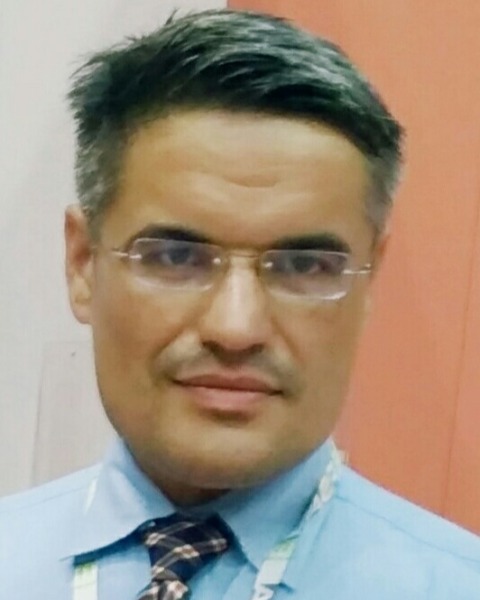Pain Rehabilitation
The effect of ultrasound-guided dry needling on the architecture and volume of the multifidus muscles in the lumbar region
Wednesday, November 1, 2023
5:50 PM - 5:56 PM
Location: Station 1

Rostyslav Bubnov, MD, PhD
MD, Ultrasound, senior researcher
Clinical hospital `Pheophania`
Kyiv, Kyyiv, Ukraine
Presenting Author(s)
Research Objectives: To investigate the effect of ultrasound-guided dry needling (DN) on the architecture and volume of the multifidus muscles in the lumbar region.
Design: This study used a pre and post-treatment design. Precise physical tests and functional neuromuscular ultrasound were conducted before and after the treatment. The patients then underwent dry needling (DN) of detected myofascial trigger points (MTrPs) under ultrasound guidance.
Setting: The study was conducted in a clinical setting of multidisciplinary clinical hospital.
Participants: The participants of the study were 20 patients with low back pain who underwent a general exam, precise physical tests, and functional neuromuscular ultrasound using M-mode and elastography.
Interventions: The patients underwent dry needling (DN) of detected MTrPs under US guidance according to [EPMA J. 2012;3(1):13.]. The thickness, width, cross-sectional area (CSA), and pennation angle (PA) of the muscles were measured before and after the treatment.
Main Outcome Measures: The main outcome measures of the study included muscle thickness, cross-sectional area (CSA), motion, muscle trabecularity, and detection of central MTrPs (multifidus muscles). The ultrasound transducer was positioned on the lumbar region, just lateral to the spinous processes of the vertebrae, in both transverse and longitudinal scans.
Results: The results of the study showed that ultrasound-guided DN led to a significant decrease in muscle thickness ranging from 23.5% to 33.3% at different lumbar levels. The PA decreased from an average of 17.2 degrees to 8.7 degrees after DN, indicating a more parallel alignment of the fibers. The thickness of the muscle fascicles, particularly in the areas with large trigger points, decreased significantly from an average of 1.8 mm to 0.9 mm. MTrPs shear wave elastography was 10-20 kPa and decreased to 3-5 kPA after treatment.
Conclusions: Ultrasound-guided DN can effectively alter the architecture of the multifidus muscles in the lumbar region, leading to a more parallel alignment of the muscle fibers and a decrease in the thickness of the muscle fascicles, particularly in the areas with trigger points.
Author(s) Disclosures: No disclosures were made in this study.
Design: This study used a pre and post-treatment design. Precise physical tests and functional neuromuscular ultrasound were conducted before and after the treatment. The patients then underwent dry needling (DN) of detected myofascial trigger points (MTrPs) under ultrasound guidance.
Setting: The study was conducted in a clinical setting of multidisciplinary clinical hospital.
Participants: The participants of the study were 20 patients with low back pain who underwent a general exam, precise physical tests, and functional neuromuscular ultrasound using M-mode and elastography.
Interventions: The patients underwent dry needling (DN) of detected MTrPs under US guidance according to [EPMA J. 2012;3(1):13.]. The thickness, width, cross-sectional area (CSA), and pennation angle (PA) of the muscles were measured before and after the treatment.
Main Outcome Measures: The main outcome measures of the study included muscle thickness, cross-sectional area (CSA), motion, muscle trabecularity, and detection of central MTrPs (multifidus muscles). The ultrasound transducer was positioned on the lumbar region, just lateral to the spinous processes of the vertebrae, in both transverse and longitudinal scans.
Results: The results of the study showed that ultrasound-guided DN led to a significant decrease in muscle thickness ranging from 23.5% to 33.3% at different lumbar levels. The PA decreased from an average of 17.2 degrees to 8.7 degrees after DN, indicating a more parallel alignment of the fibers. The thickness of the muscle fascicles, particularly in the areas with large trigger points, decreased significantly from an average of 1.8 mm to 0.9 mm. MTrPs shear wave elastography was 10-20 kPa and decreased to 3-5 kPA after treatment.
Conclusions: Ultrasound-guided DN can effectively alter the architecture of the multifidus muscles in the lumbar region, leading to a more parallel alignment of the muscle fibers and a decrease in the thickness of the muscle fascicles, particularly in the areas with trigger points.
Author(s) Disclosures: No disclosures were made in this study.
Learning Objectives:
- List the potential benefits of ultrasound imaging in assessing muscle architecture and function in patients with low back pain.
- Describe the technique and benefits of ultrasound-guided dry needling in altering muscle thickness, fascicle thickness, and pennation angle in patients with trigger points in their muscles.
- Define the concept of muscle hypertonicity and its potential role in the development of myofascial pain syndromes and related conditions.
- Demonstrate an understanding of the potential mechanisms by which ultrasound-guided dry needling may reduce muscle hypertonicity and trigger point-related changes in the multifidus muscles.
- Discuss the findings from this study and the implications for future research on the use of ultrasound-guided dry needling in the treatment of low back pain.

.jpg)
